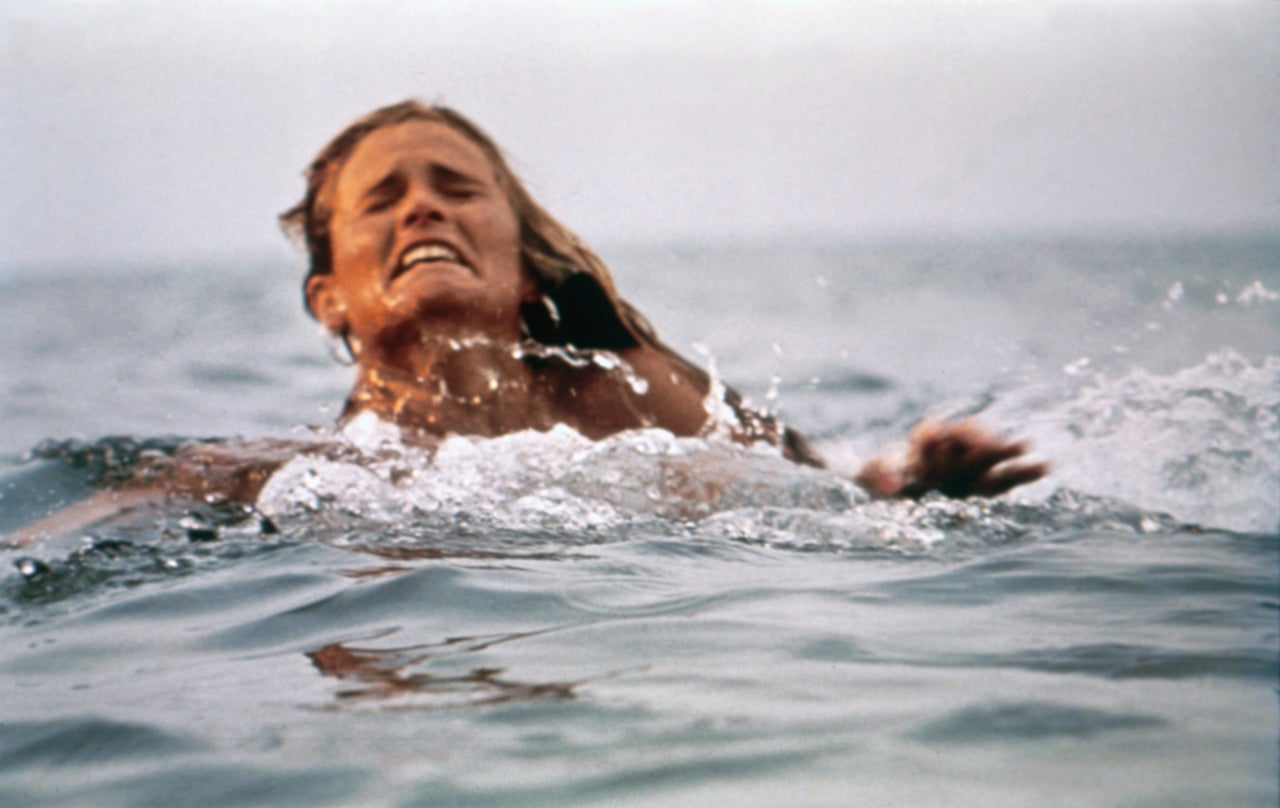Last summer, a great white shark washed up on the shore of Nantucket, Massachusetts. When a family on vacation came across the beached behemoth as it flailed in the shallow waves, they made a surprising choice. Members of the group cautiously approached the shark and pushed it back into the ocean. Video of the event quickly went viral — a feel-good story with a hint of danger.
But 50 years ago, during the same summer that “Jaws” first swam into theaters, a similar encounter might have gone very differently.
On June 20, 1975, Steven Spielberg unleashed “Jaws” on the world, inventing the modern blockbuster and launching a global fascination with sharks. It was the first film to gross more than $100 million at the U.S. box office, according to the American Film Institute. Based on the best-selling book by Peter Benchley, “Jaws” sparked a surge of interest in studying the ancient apex predator — and an obsession with hunting sharks as trophies.
“When ‘Jaws’ came out, there was an uptick in shark tournaments,” said Wendy Benchley, a longtime ocean conservationist who is married to the “Jaws” author and appears in the upcoming National Geographic documentary “Jaws @ 50.” “This fictional book and movie somehow gave people the license to kill sharks.”
In the half-century since, our understanding of great white sharks has increased dramatically, but there’s much we still don’t know about the ruler of the sea. At the same time, shark populations around the world have decreased dramatically due to overfishing, although sightings (and attacks) have increased recently along the East Coast of the United States for reasons that scientists still don’t fully understand.
“Jaws” may have sparked our collective fascination with sharks, but 50 years later, the reality is far more complicated than Peter Benchley or Steven Spielberg ever could have imagined.
The Impact Of ‘Jaws’
Fotos International via Getty Images
The first time she went scuba diving after seeing “Jaws,” Wendy Benchley was admittedly a little freaked out.
“‘Jaws’ touched our innate fear of being eaten by a monster fish,” she said. “I’m not dismissing the fact that it is a very real, visceral fear for people.”
The movie’s impact was literally deadly. Inspired by Robert Shaw’s portrayal of gruff shark hunter Quint, some “Jaws” fans decided to participate in shark-hunting tournaments. The number of recorded great whites caught and killed by humans around the world spiked in the three years after “Jaws” was released.
“One of the things I still fear [is] not to get eaten by a shark, but that sharks are somehow mad at me for the feeding frenzy of crazy sports fishermen that happened after 1975,” Spielberg said on BBC Radio 4’s “Desert Island Discs” in 2022. “I truly and to this day regret the decimation of the shark population because of the [‘Jaws’] book and the film. I really, truly regret that.”
But while that fad quickly passed, the positive impacts were long-lasting. The movie unleashed a wave of marine scientists in the mold of Richard Dreyfuss’ character, Matt Hooper. According to Benchley, enrollment at the Rosenstiel School of Marine Science at the University of Miami increased by 30% in response. (It’s unclear how many people saw “Jaws” and decided to become beach-town police chiefs, inspired by Roy Scheider’s protagonist, Martin Brody.)
Shark Populations Are On The Decline
“Jaws” may not be responsible for it, but there’s no denying the global shark population has plunged in the 50 years since the film’s release. According to a report published in the scientific journal Nature in 2021, the number of sharks and rays in the ocean has dropped by 71% since 1970, largely due to an 18-fold increase in fishing.
According to Benchley, the numbers are even more dire.
“We only have 10% of the sharks left that we had in the ocean 40 years ago,” she said.
The cause is overfishing (massive ships that sweep the ocean and pull up fish and other creatures indiscriminately), along with the popularity of shark fin soup in China and other Asian countries. The wildlife nonprofit organization WildAid has managed to reduce demand for the delicacy by 85%, according to Benchley, through a publicity campaign that enlisted celebrities like Yao Ming and Jackie Chan.
And if you’re wondering why it’s important to protect dwindling shark populations (aside from general conservation reasons), Benchley put it simply: “You’ve got to have apex predators in the ocean to keep the ecosystem in balance.”
Are Shark Attacks On The Rise?

Sunset Boulevard via Getty Images
Globally? No. The total number of recorded unprovoked shark bites in 2024 was 47, down from an annual average of 64 in recent years, according to an annual report from the International Shark Attack File. But along the East Coast of the United States, both sightings and bites are on the rise.
The same ISAF report revealed Florida is the most likely place to see a shark in the world, with 14 bites in 2024. Meanwhile, a 2023 shark attack on Rockaway Beach in Queens, New York, marked the first such incident in the state since the 1950s. Further north, Cape Cod has become a hot spot for great whites, frustrating tourists and locals who can no longer enjoy the peninsula’s ocean-facing beaches.
The primary reason for this shark resurgence is the return of another aquatic animal: seals. Increased seal populations in the region, thanks to a deliberate conservationist effort, have attracted their natural predator.
“There are more great white sharks along the East Coast, and that is an environmental success story,” Benchley said.
“Sharks do not like humans. We don’t have enough fat on us. They’d much rather have a seal.”
– Wendy Benchley, ocean conservationist
However, climate change may also be partially to blame. Scientists speculate that warming oceans could attract other marine life, which would then attract hungry sharks. And while great whites were long believed to prefer colder water, one 2024 study found that the younger ones enjoy warm, shallow seas.
Regardless of the reason, great white sharks have returned to the East Coast. While Benchley sees this as a positive, she also recognizes why swimmers are concerned and offers some practical advice: Stay in the shallow water, don’t swim in the morning or at night, and most importantly, stay away from seals.
“Sharks do not like humans,” Benchley said. “We don’t have enough fat on us. They’d much rather have a seal.”
The Legacy Of ’Jaws’
When it comes to great white sharks and our relationship with these magnificent, deadly creatures, “Jaws” leaves behind a complex legacy. The same movie that inspired audiences to hunt sharks for sport also persuaded a generation of scientists to study the species and work to save it from extinction.
Ultimately, Benchley takes solace in the fact that, 50 years after “Jaws,” when a random group of people found a beached shark in Nantucket, their first instinct wasn’t to kill the fish (or to run away screaming), but to save it. For a woman whose husband taught us all to fear the ocean — and who then spent her life working to preserve it — that’s a victory.
“Thank heavens,” she said. “People finally understand how vital sharks are.”
“Jaws @ 50: The Definitive Inside Story” premieres on National Geographic on July 10. It will stream on Hulu and Disney+ on July 11.
Read the full article here








